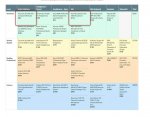Hi all, after many many hours researching and coding I just recently finished a site that helps people start a hobby - with music production being one of them. Essentially it's a table that's broken down into rows which reflect some of the best quality gear at the respective budget level, so as you go down the table the quality/price balance increases. I noticed that many people ask the same questions such as "What are the best headphones for under $xx" and things of that nature and figured this table would help a lot of new music producers get started with less hassle carving through dozens of articles and threads.
Here is the table: Music Production Table
I know there are always slighter better options that might be overlooked as new things come out / prices change and appreciate any room for improvement as far as microphones (or other gear) goes. If you do want to make an improvement just try to remember to balance quality/price for the respective row. I hope this helps some of you, cheers!
Here is the table: Music Production Table
I know there are always slighter better options that might be overlooked as new things come out / prices change and appreciate any room for improvement as far as microphones (or other gear) goes. If you do want to make an improvement just try to remember to balance quality/price for the respective row. I hope this helps some of you, cheers!


